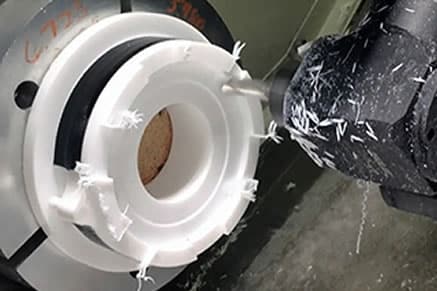
One of the best ways to fabricate Teflon parts is CNC machining. This article looks at the ins and outs of machining Teflon: its material properties, the advantages of machining it, common applications, and more.
What is Teflon?
PTFE is a thermoplastic and a fluoropolymer of tetrafluoroethylene. The name ‘Teflon’ is a brand name of American chemical company Chemours, a spinoff from chemical giant DuPont (now DowDuPont). Interestingly, the material was initially discovered by mistake.
A white solid at room temperature, PTFE consists of carbon and fluorine only. It is hydrophobic, has incredibly low friction, and is non-reactive due to the very strong bonds between carbon and fluorine, one of the strongest existing bonds in organic chemistry. Due to its low friction — it is the only surface a gecko cannot stick to! — Teflon is often used as a lubricant.
The melting point of PTFE is 327 °C, and other material properties include strength, toughness, and self-lubrication at low temperatures.
Polytetrafluoroethylene (PTFE), most commonly known by the brand name Teflon, is a synthetic fluoropolymer thermoplastic that can be used for a range of applications, from non-stick frying pans to medical devices.
Resistant to chemicals and stable even at high temperatures, Teflon is one of the popular CNC machining and milling plastics for many specific applications, despite its so-so mechanical properties. As is the case with non-stick frying pans, it is sometimes used as a coating rather than a base material, and it can be manufactured in several ways.
Advantages of machining Teflon
There are several advantages to Teflon machining, including inherent material advantages of PTFE and advantages derived from the process of machining.
Material advantages of machining Teflon include:
Chemically resistant
UV/weather resistant
Water resistant; hydrophobic
High impact strength
Good electrical insulator
Flexible even at low temperatures
Thermal stability between -260°C and 260°C
Very low coefficient of friction
Low flammability
Food-safe
Easy to clean
Process advantages of machining Teflon include:
Easily machinable due to softness and density
Excellent thermal stability prevents part deformation and tool clogging
Limitations of machining Teflon
High coefficient of expansion
Stress creep
Difficult to achieve tight tolerances
Poor mechanical properties
Poor dimensional stability
Risk of burrs due to material softness
Applications of Teflon machining
Teflon is not the most versatile material for CNC machining, but it has some important niche applications due to its desirable properties like thermal stability and a low friction coefficient.
About half of all PTFE in the world is used for wire insulation, but wiring and its insulation is not made using CNC machines. The other most well-known use of Teflon is for non-stick coatings on aluminum cookware; in this case, Teflon in its liquid form is sprayed or rolled onto the etched metal surface. In general, Teflon-lined cookware is not machined.
Nonetheless, CNC machining is useful for manipulating Teflon in its solid form. Teflon parts suitable for machining include industrial components like gears, bushings, fittings, and valves.
Some commonly CNC machined PTFE parts, used in industries like medicine, food processing, science, and aerospace, include:
Valves
Fittings
Bearings
Bushings
Manifolds
Insulators
Gears
O-rings
Teflon machining tips
Teflon parts must be designed to suit the properties of PTFE; it does not behave like common machinable thermoplastics, and is not easily substituted in for more common materials.
That being said, Teflon is suitable for a variety of parts and components if proper care and precaution is taken by both designer and machinist. An achievable tolerance for Teflon parts is around 0.13 mm — tighter than this may be difficult without stress-relieving the material in advance.
When CNC machining Teflon, very sharp tools combined with water-soluble coolants such as pressurized air and spray mists work well to produce the best surface finishes and tolerances. Non-aromatic coolants are also preferable.
Another key consideration when machining Teflon is deburring. Because PTFE is so soft, even fine, sharp cutting tools can produce undesirable marks that require post-processing treatment.
Common surface finishing techniques like sanding can be used to remove burrs, although a more advanced method involves freezing the machined Teflon to make it less soft during the deburring process.
Use very sharp cutting tools
Apply liberal amounts of water-soluble coolant
Aim for medium-to-loose tolerance
Plan a deburring strategy in advance
Teflon alternatives
Similar materials to Teflon may be substituted in for certain projects, either for practical or budgetary reasons.
ECTFE: Ethylene chlorotrifluoroethylene is a semi-crystalline fluoropolymer and a copolymer of ethylene and chlorotrifluoroethylene. It is made by chemical company Solvay under the brand name Halar ECTFE and offers slightly superior chemical and corrosion resistance.
PFA: Perfluoroalkoxy is another fluoropolymer with similar properties to PTFE. Although softer and less abrasion-resistant than Teflon, advantages of PFA include arguably better non-stick properties. PFA is less commonly machined than Teflon.
PCTFE: Polychlorotrifluoroethylene is a thermoplastic chlorofluoropolymer similar to PTFE. Advantages include an incredibly high level of water resistance: it has the lowest water vapor transmission rate of any plastic.
XTJ is a leading OEM Manufacturer that is dedicated to providing one-stop manufacturing solutions from prototype to production. We are proud to be an ISO 9001 certified system quality management company and we are determined to create value in every customer relationship. We do that through collaboration, innovation, process improvements, and exceptional workmanship.

